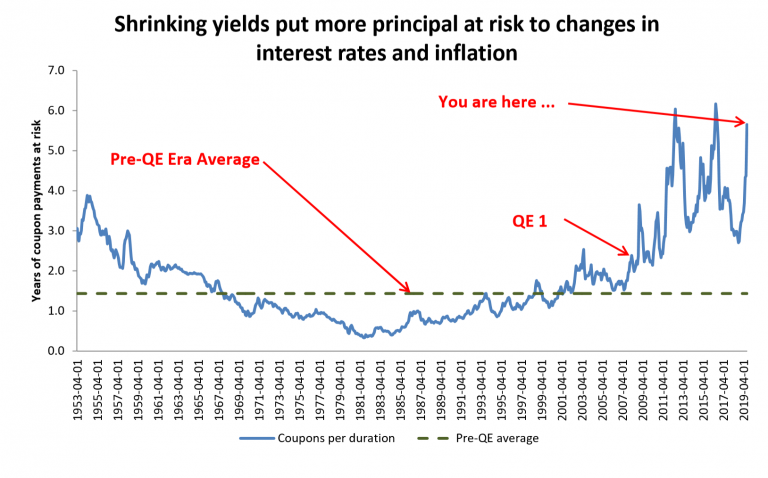by Seth Levine, The Integrating Investor
“Remember that Time is Money.”
Benjamin Franklin, Advice to a Young Tradesman
It’s unfortunate that such genius identifications as the above have long been forgotten by the economic community. First penned in 1748, Benjamin Franklin makes the connection between human effort—or rather the application of human effort towards productive work—and the effect/product, i.e. wealth. We measure this increase in prosperity, of course, in terms of money. Thus, “Time is Money” (or rather, time is potential money). They are one in the same since time is the one truly scarce resource with which all living creatures have to work.
However, you’d never know this by a look at today’s markets. Negative interest rates are now common place and widely accepted as a policy tool. In fact, a tradition of thought is being established as a means of “normalizing” them. Pushing deeper into negative territory seems all but a foregone conclusion. No longer is the absurdity and devastation of such policies discussed. No longer discussed is that negative interest rates negative human life.
Negative Interest Rates Negate Human Life
“Negative interest rates negative human life” is a bold statement, I know, but I stand by it. I suspect “Big Ben” would too. We both understand what economics is all about. It has nothing to do with fine tuning commercial activities for some nebulous greater good. Rather, economics is about individual, human happiness. It’s about making the most of our time on this planet; to use our time, effort, and brainpower to maximize the human experience while it lasts. The better use of time we make—via productivity—the more wealth can be created, the more comfortable and fulfilling our lives, and the better the existence we can enjoy. Hence, time is money in a pure, genuine, and profound way.
This is why negative interest rate policies (NIRP) are so pernicious and beyond absurd, irrespective of whether or not they saved the collapsing financial system in 2008. NIRP implies contractions on such fundamental scales that they cannot be beneficial. Specifically, that either: 1) your time and efforts are valueless (or worse, destructive), or; 2) your currency is valueless. In other words, action is detrimental to survival; time is not money, and; one’s currency choice is not important. None could be more obviously false.
Time and Effort Are Valuable
Your time and effort are valuable. Fundamentally, these are your survival tools. If time and effort were not valuable then there would be no need to ever take any action of any sort. You’d be better served to lay curled up in the fetal position than to attempt to work. This is clearly false. Human survival (and thriving beyond this basic need) requires one to produce and trade for values. This requires action; hence time and effort are valuable.
Time is Money
If time were not money then no one would work, full stop. Why toil if the fruits of one’s labor did not exceed the effort and time spent while working? Humans work for the purpose of survival; however we’re lucky that civilization has sufficiently advanced such that immediate survival is no longer of primary concern for much of the developed world.
Instead of concerning ourselves with food and shelter, human effort can be diverted towards life enhancements. Today, engineers make software, artists make films, ride-sharing drivers transport us, and financiers fund dreams. Without people working on such projects there would be none of the results. There’d be no Ubers and iPhones and movies and biotechnology and office buildings without men and women applying their time towards these endeavors.
If time were not money why on earth would anyone work? Surely there would be better ways to spend one’s only truly scare resource of time. Simply doing nothing and conserving energy would be an evolutionary advantage. Why work if there are no values to gain?
Working to lose would favor not working or acting at all. This is the absurdity of negative interest rates. To apply capital only to lose it—i.e. NIRP—would favor not applying capital in the first place. Thus, NIRP’s existence implies a contrived construct to exist, not one grounded in natural law.
Sound Money Is Universally Desired
Another possibility of NIRP is that it says something negative about the currency and not necessarily output. The currency is depreciating over time. But this too is nonsensical. Why would anyone use a depreciating currency given the choice? In fact, no one ever chooses such inferior currency, looking at history. These circumstances typically arise with a healthy dose of force. Poor currencies are typically foisted upon an unwilling population and they typically don’t last; no one wants to lose value in a transaction. If a currency cannot serve as a reliable unit of account, the populace will eventually find something that can—officially or unofficially sanctioned.
Thus, people will flock to the best currency option available so long as they are not forced to choose otherwise by regulation and statute. This in part explains the U.S. Dollar’s dominance in international financial transactions. True it’s the “reserve currency” but it’s the reserve currency for a reason and the dominance of the U.S. Navy is not one. Rather, the respect for the rule of law, deep capital pools, and established and incentivized institutions are what likely preserves the U.S. Dollar’s reserve status. Don’t kid yourself; an IMF mandate for settling trade in renminbi would yield no (material) results. Economic actors will act according to their best interests, factoring in the price of non-compliance. Thus, the “bag-holders” are always those compelled to hold depreciating currency.
Sweet Siren’s Song
The challenge with negative and low rates is just how profitable they can be to trade. Hence, they should not be ignored, in my view. I introduced the chart below nearly a year ago. It illustrates how much return potential is embedded in the 10 year U.S. Treasury bond (USTs) expressed as a function of its current yield (see here for a more detailed description). As yields have fallen, the appreciation/depreciation potential has dramatically increased. No longer are USTs boring, yield providing investment vehicles. In the environments of NIRP and ZIRP (zero interest rate policy) they are now total-rate-of-return vehicles ripe for speculation and outperformance.
Today’s Bizarre State of the World
These dynamics gave us the current state of the world. Investors cheer the stupidity of NIRP because they yield profits. The more ZIRP, NIRP, and QE (quantitative easing) the more capital gains can be reaped despite no detectable economic benefits produced. Hence, investors cheer the nonsensical which policymakers mistake as as endorsements. A self-reflective loop is established.
Many claim that NIRP, ZIRP, and QE saved the failing financial system. This, however, is mere conjecture. We simply don’t know what would have arisen from the ashes, better or worse. Counter-factual claims cannot be empirically debated.
Thus to claim that NIRP is beneficial displays one’s bias and, in my view, is grounds for mistrust on non-objectivity. This is particularly true since we can see how truly absurd the theoretical construct for NIRP is. Time is money and freely exchanging citizens desire sound currency, these we know as fact. Arguing to the contrary in papers or by inciting tradition can’t negate these.
So long as the academic and political will favors the incumbent policies they will likely be entrenched. The IMF recently published their playbook for the next economic slowdown and NIRP plays prominently. Economics (true economics) illustrate why these next rounds will also fail to stoke economic activity.
There’s no breaking the link between time and money and the desirability for sound currency. These are universal truths. That said, bond math illustrates that trading “rates” in such an absurd environment can be lucrative, at least for the time being. Thus, I find it useful to know both: the absurd and the trading potential. Profitably trading won’t negate the deleterious effects of NIRP, but it can help preserve one’s capital for better, more intellectually sound times.
About the author
Seth Levine is a professional, institutional investor. He is also the creator of The Integrating Investor where he blogs about macroeconomic and investment strategy related themes. Seth holds a Bachelor of Science degree in Mechanical Engineering from Cornell University and is a CFA charterholder. You can learn more about Seth at www.integratinginvestor.com and follow him on Twitter at @SethLevine2. Please note that any opinions and views he expresses are solely his own and do not reflect those of his current of former employers.
Copyright © The Integrating Investor


















